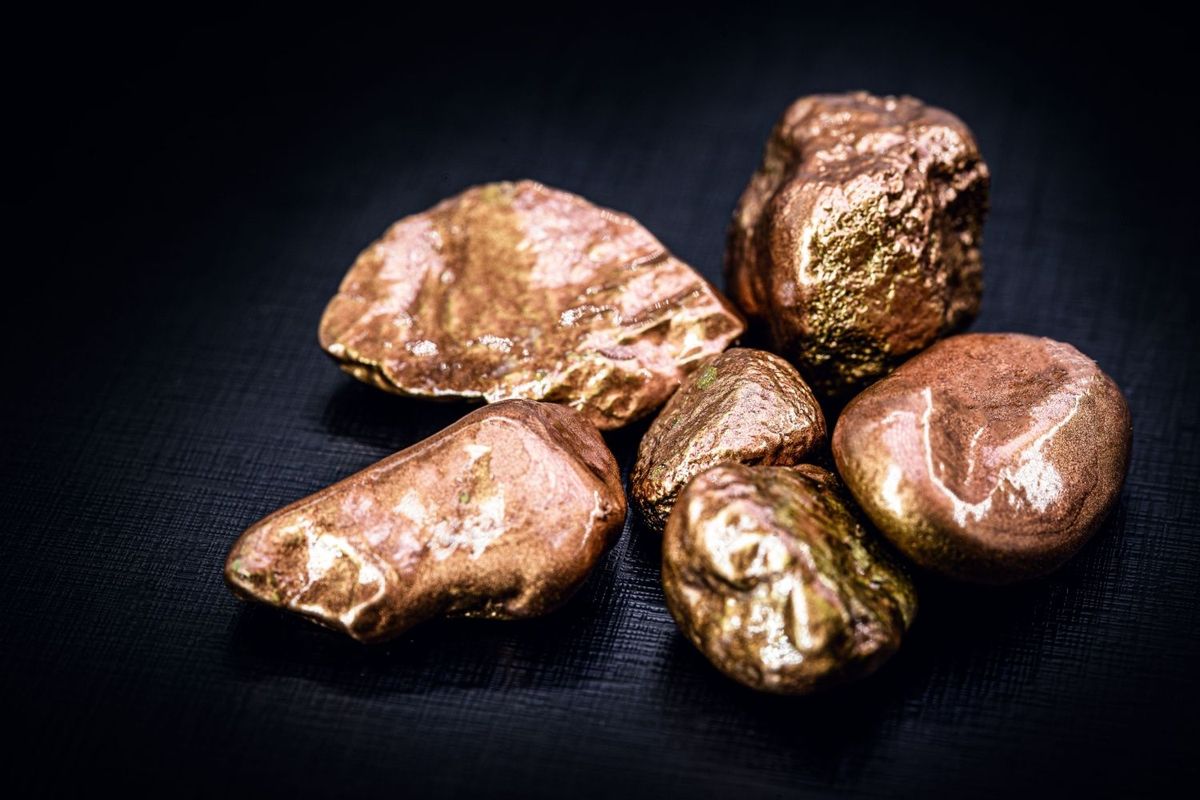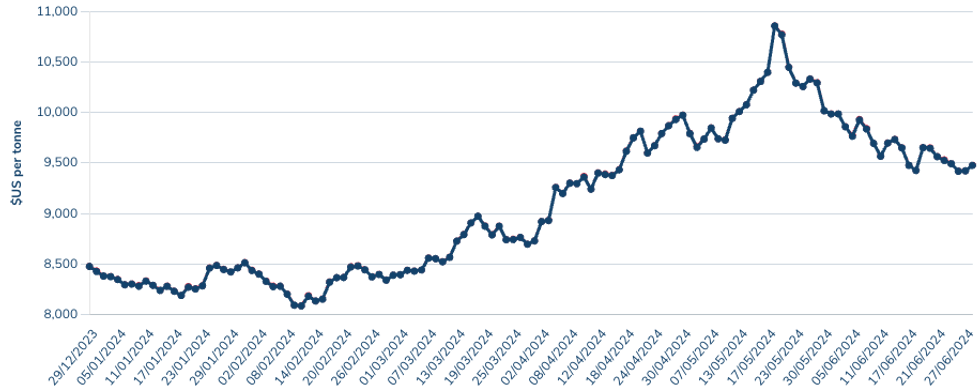Copper Price Update: Q2 2024 in Review
The second quarter of 2024 saw supply and demand forces push the price of copper to record levels on the LME and COMEX.

The second quarter of 2024 saw copper prices surge on the London Metal Exchange (LME) on the back of supply bottlenecks and elevated demand, particularly from the energy sector.
Copper prices began the period at US$8,728 per metric ton (MT) on April 3, but supply and demand dynamics provided critical support for the base metal — by the end of the month, copper had climbed to US$9,973.50.
With an improving macroeconomic environment in the US increasing the likelihood of an interest rate cut and continued cuts at Chinese refiners in May, copper encountered a perfect storm that helped it set a record high on the LME of US$11,104.50 on May 20. It hit an even higher price on the COMEX of US$5.20 per pound, or US$11,464, the same day.
Copper prices pulled back to end Q2 at US$9,418. Although the metal had retreated to US$9,051.50 as of July 22, it remains at elevated levels, with conditions likely to continue providing support for the near future.
Copper supply struggles lead to tight market in Q2
Both a loss of existing supply and a lack of incoming supply are supporting copper prices this year.
The closure of First Quantum Minerals' (TSX:FM,OTC Pink:FQVLF) Cobre Panama mine in Panama has weighed on supply; it accounted for approximately 1 percent of global copper supply when it was operational.
The mine is currently in care and maintenance, with negotiations halted. José Raúl Mulino, Panama's new president, has said his government won’t engage in new negotiations unless First Quantum drops its arbitration claims.
In an interview with the Investing News Network, Joe Mazumdar, editor of Exploration Insights, spoke briefly about the situation in Panama. “From what I understand, most of the people that ran for presidential election were all against the project,” he commented. “I don’t think there’s anybody there that is for the project winning. So then it’s all about arbitration, which will drag on for a while as it's a big number, US$20 billion.”
He believes the situation will impact investment decisions elsewhere as well. “It will also make people and companies rethink spending significant capital in jurisdictions if they don’t have government support,” he said.
Elsewhere in the copper sector, the news has been mixed at best. Despite predicting lower grades and reduced production at its Quellaveco mine, Anglo American (LSE:AAL,OTCQX:AAUKF) saw an 11 percent year-on-year increase during the first quarter as the mine achieved its highest throughput rate.
Even so, the major miner has set its copper production guidance at 730,000 to 790,000 MT for 2024, substantially lower than the 826,000 MT of copper output it recorded in 2023.
“We’ve also had a secular negative trend in production with the largest copper producer, which is Codelco. They’ve got problems with large amounts of debt, so their ability to fund their expansions is problematic,” Mazumdar said.
Codelco, Chile’s state-run mining company, saw production slump to 25 year lows in 2023. This year, the firm is struggling to meet its 2024 production targets as a new mandate from the Chilean government has prioritized lithium production, and the Chuquicamata and El Teniente mines continue to be plagued by long-term debt issues.
Lower production levels have stressed treatment charges since the start of the year, forcing Chinese refiners to begin their own production cuts earlier in the year. However, these cuts have done little to raise margins, and producers have begun to plan for additional cuts in Q3 as lower rates begin to affect annual deals that benefit refiners.
Mazumdar said that the majority of mines produce copper concentrate, for which 50 percent of the smelting capacity is in China. The end price is dictated by treatment and refining charges, which he said have gone low and nearly turned negative due to the lack of concentrate available after Cobre Panama was suspended.
The Exploration Insights expert went on to say that the other price to look at when analyzing copper markets is copper cathode premiums, which reflect cathode supply and demand.
“So there’s the cathode price. That’s stated in the LME, and Shanghai and the COMEX in the states. But if the market is tight in any of those regions locally, you will see a cathode premium … over the price of the copper,” he said. “People are willing to pay more to incentivize people that have copper inventory to release it into the market.”
According to Mazumdar, if both treatment and refining charges are low and the cathode premiums are high, that is indicative of a tight near-term market.
Electrification helping to drive copper demand
Higher prices also reflect a recovery from the manufacturing sector, as well as higher demand from industries tied to the global energy transition. Electricity generation in general is a large driver of copper demand, and renewable energy options such as solar and wind consume even larger amounts of copper.
According to the US Energy Information Administration, US electricity generation increased 5 percent during the first six months of 2024 compared to H1 2023; during H2, electricity generation is expected to be up 2 percent.
The report also indicates that solar generation is currently the fastest-growing source of electricity generation. Solar generation was up significantly in the US year-on-year in the first half of 2024, and the Energy Information Administration expects it to grow 42 percent year-on-year during the second quarter.
This comes alongside increases in installed solar and wind, particularly in China, which saw record-setting installations of wind and solar projects as installed solar costs dropped below prices for any other energy source.
Renewable usage is also increasing with corporations. S&P Global Commodity Insights notes that corporate renewable capacity increased by 15.8 gigawatts worth of contracts signed in the first quarter, representing a 36 percent increase from the same time in 2023. Of those, solar led the way and made up roughly half of the deals signed.
The report indicates that the mineral extraction sector saw strong renewable growth, including 2.5 gigawatts of deals signed by Rio Tinto (ASX:RIO,LSE:RIO,NYSE:RIO) as it works to improve its carbon footprint at its Australian operations.
Significant copper demand has also been coming from electric vehicle (EV) producers. Although reports about EV sales slowdowns have been rife since 2023, many US carmakers have experienced strong growth in 2024.
During the first half of the year, US EV sales saw an 11.3 percent increase over 2023, with 330,463 units sold. Globally, sales were even stronger, increasing 20 percent to 7 million units sold.
China held its position as the strongest EV market, accounting for 4.1 million of those sales.
EVs can use as much as 60 kilograms of copper versus the 25 kilograms in traditional internal combustion engine cars, and 29 kilograms in hybrids. Electrical demands on the grid will require even greater amounts of copper.
A May report from the International Energy Forum, a body established to facilitate dialogue between energy-producing and energy-consuming countries, suggests that current goals for 100 percent EV production by 2035 are unrealistic. Instead, it recommended the goal be moved to the manufacturing of hybrids instead.
The forum also notes that the average copper production output of the top 10 mines is 472,000 MT per year, and in order to maintain current increases to demand, 1.1 new mines will need to be added every year until 2050. When EVs and their demands on the electric grid are factored in, that rises to 1.7 new mines per year, or 54 new mines by 2050.
What can copper investors expect in 2024?
In the short term, there is still copper supply in the market, but the situation could quickly change.
The Chinese real estate market, which has traditionally been a major demand generator for copper, hasn’t recovered yet, and a shift there could send an already tight market over the edge. Chinese officials have made attempts to revive the flagging sector, but the initiatives have had little effect and are threatening to drag the economy down further.
However, softer copper demand from the Chinese housing sector has largely been offset by increased demand from EVs, as well as the country's attempt to move away from fossil fuel to meet its energy needs.
As for incoming supply, Mazumdar noted that funding for copper projects is tentative due to rising costs and the fact that copper prices haven't been conducive to building new projects. Additionally, projects that have seen development won’t come online in time to fill gaps in production as they've been held back.
He suggested that copper producers are looking to avoid the kind of cost overruns experienced with Teck Resources' (TSX:TECK.A,TECK.B,NYSE:TECK) Quebrada Blanca 2 expansion, which has ballooned from US$4.7 billion to US$8.8 billion. However, Mazumdar said it is encouraging that Freeport-McMoRan (NYSE:FCX) announced a decision to expand its El Abra copper mine in Chile for US$7.5 billion.
Additionally, while M&A is taking place in the industry, it has largely been focused on producing assets.
“They don’t mind paying a premium for a producing mine because it's permitted for the tailings and other footprints, and the capital has been spent, so there is little capital escalation risk,” Mazumdar said.
He also suggested that permitting issues are a major factor for timelines, causing investors to rethink where their capital flows to. These long permitting times are resulting in companies turning to jurisdictions with more government support for critical metals, as with Barrick Gold's (TSX:ABX,NYSE:GOLD) projects in Pakistan.
“Why spend a premium on a project that might take 10+ years to permit when you can spend as much or less on a project that you can get funded in an area that might take half the time to put into production,” he said.
With limited supply and little to be done to ease permitting times, copper demand is likely to keep the market bullish. This demand may be good news for investors looking to find opportunities in the resource sector, as copper is critical in the medium and long term to energy transition goals around the world.
Don’t forget to follow us @INN_Resource for real-time news updates!
Securities Disclosure: I, Dean Belder, hold no direct investment interest in any company mentioned in this article.
Editorial Disclosure: The Investing News Network does not guarantee the accuracy or thoroughness of the information reported in the interviews it conducts. The opinions expressed in these interviews do not reflect the opinions of the Investing News Network and do not constitute investment advice. All readers are encouraged to perform their own due diligence.
- What Factors Affect Copper Supply and Demand? ›
- What Was the Highest Price for Copper? (Updated 2024) ›
- Is Now a Good Time to Invest in Copper? Panelists Tout Long-term Fundamentals ›
- When Will Copper Go Up? ›






